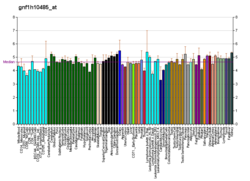GCNT2
Appearance
(Redirected from GCNT2 (gene))
N-acetyllactosaminide beta-1,6-N-acetylglucosaminyl-transferase is an enzyme that in humans is encoded by the GCNT2 gene.[5][6][7]
This gene encodes the enzyme responsible for formation of the blood group I antigen. The i and I antigens are distinguished by linear and branched poly-N-acetyllactosaminoglycans, respectively. The encoded protein is the I-branching enzyme, a beta-1,6-N-acetylglucosaminyltransferase responsible for the conversion of fetal i antigen to adult I antigen in erythrocytes during embryonic development. Mutations in this gene have been associated with adult i blood group phenotype. Alternatively spliced transcript variants encoding different isoforms have been described.[7]
References
[edit]- ^ a b c ENSG00000285222 GRCh38: Ensembl release 89: ENSG00000111846, ENSG00000285222 – Ensembl, May 2017
- ^ a b c GRCm38: Ensembl release 89: ENSMUSG00000021360 – Ensembl, May 2017
- ^ "Human PubMed Reference:". National Center for Biotechnology Information, U.S. National Library of Medicine.
- ^ "Mouse PubMed Reference:". National Center for Biotechnology Information, U.S. National Library of Medicine.
- ^ Bierhuizen MF, Mattei MG, Fukuda M (Apr 1993). "Expression of the developmental I antigen by a cloned human cDNA encoding a member of a beta-1,6-N-acetylglucosaminyltransferase gene family". Genes Dev. 7 (3): 468–78. doi:10.1101/gad.7.3.468. PMID 8449405.
- ^ Yeh JC, Ong E, Fukuda M (Mar 1999). "Molecular cloning and expression of a novel beta-1, 6-N-acetylglucosaminyltransferase that forms core 2, core 4, and I branches". J Biol Chem. 274 (5): 3215–21. doi:10.1074/jbc.274.5.3215. PMID 9915862.
- ^ a b "Entrez Gene: GCNT2 glucosaminyl (N-acetyl) transferase 2, I-branching enzyme (I blood group)".
Further reading
[edit]- Fukuda M, Fukuda MN, Hakomori S (1979). "Developmental change and genetic defect in the carbohydrate structure of band 3 glycoprotein of human erythrocyte membrane". J. Biol. Chem. 254 (10): 3700–3. doi:10.1016/S0021-9258(18)50640-2. PMID 438154.
- Keats B, Ott J, Conneally M (1989). "Report of the committee on linkage and gene order". Cytogenet. Cell Genet. 51 (1–4): 459–502. doi:10.1159/000132805. PMID 2791656.
- Bierhuizen MF, Maemura K, Kudo S, Fukuda M (1995). "Genomic organization of core 2 and I branching beta-1,6-N-acetylglucosaminyltransferases. Implication for evolution of the beta-1,6-N-acetylglucosaminyltransferase gene family". Glycobiology. 5 (4): 417–25. doi:10.1093/glycob/5.4.417. PMID 7579796.
- Magnet AD, Fukuda M (1997). "Expression of the large I antigen forming beta-1,6-N-acetylglucosaminyltransferase in various tissues of adult mice". Glycobiology. 7 (2): 285–95. doi:10.1093/glycob/7.2.285. PMID 9134435.
- Sasaki K, Kurata-Miura K, Ujita M, et al. (1998). "Expression cloning of cDNA encoding a human beta-1,3-N-acetylglucosaminyltransferase that is essential for poly-N-acetyllactosamine synthesis". Proc. Natl. Acad. Sci. U.S.A. 94 (26): 14294–9. doi:10.1073/pnas.94.26.14294. PMC 24948. PMID 9405606.
- Olavesen MG, Bentley E, Mason RV, et al. (1998). "Fine mapping of 39 ESTs on human chromosome 6p23-p25". Genomics. 46 (2): 303–6. doi:10.1006/geno.1997.5032. PMID 9417921.
- Yu LC, Twu YC, Chang CY, Lin M (2002). "Molecular basis of the adult i phenotype and the gene responsible for the expression of the human blood group I antigen". Blood. 98 (13): 3840–5. doi:10.1182/blood.V98.13.3840. PMID 11739194.
- Potter KN, Hobby P, Klijn S, et al. (2002). "Evidence for involvement of a hydrophobic patch in framework region 1 of human V4-34-encoded Igs in recognition of the red blood cell I antigen". J. Immunol. 169 (7): 3777–82. doi:10.4049/jimmunol.169.7.3777. PMID 12244172.
- Yu LC, Twu YC, Chou ML, et al. (2003). "The molecular genetics of the human I locus and molecular background explain the partial association of the adult i phenotype with congenital cataracts". Blood. 101 (6): 2081–8. doi:10.1182/blood-2002-09-2693. PMID 12424189.
- Inaba N, Hiruma T, Togayachi A, et al. (2003). "A novel I-branching beta-1,6-N-acetylglucosaminyltransferase involved in human blood group I antigen expression". Blood. 101 (7): 2870–6. doi:10.1182/blood-2002-09-2838. PMID 12468428.
- Strausberg RL, Feingold EA, Grouse LH, et al. (2003). "Generation and initial analysis of more than 15,000 full-length human and mouse cDNA sequences". Proc. Natl. Acad. Sci. U.S.A. 99 (26): 16899–903. Bibcode:2002PNAS...9916899M. doi:10.1073/pnas.242603899. PMC 139241. PMID 12477932.
- Zhang T, Haws P, Wu Q (2004). "Multiple variable first exons: a mechanism for cell- and tissue-specific gene regulation". Genome Res. 14 (1): 79–89. doi:10.1101/gr.1225204. PMC 314283. PMID 14672974.
- Ota T, Suzuki Y, Nishikawa T, et al. (2004). "Complete sequencing and characterization of 21,243 full-length human cDNAs". Nat. Genet. 36 (1): 40–5. doi:10.1038/ng1285. PMID 14702039.
- Pras E, Raz J, Yahalom V, et al. (2004). "A nonsense mutation in the glucosaminyl (N-acetyl) transferase 2 gene (GCNT2): association with autosomal recessive congenital cataracts". Invest. Ophthalmol. Vis. Sci. 45 (6): 1940–5. doi:10.1167/iovs.03-1117. PMID 15161861.
- Gerhard DS, Wagner L, Feingold EA, et al. (2004). "The status, quality, and expansion of the NIH full-length cDNA project: the Mammalian Gene Collection (MGC)". Genome Res. 14 (10B): 2121–7. doi:10.1101/gr.2596504. PMC 528928. PMID 15489334.






